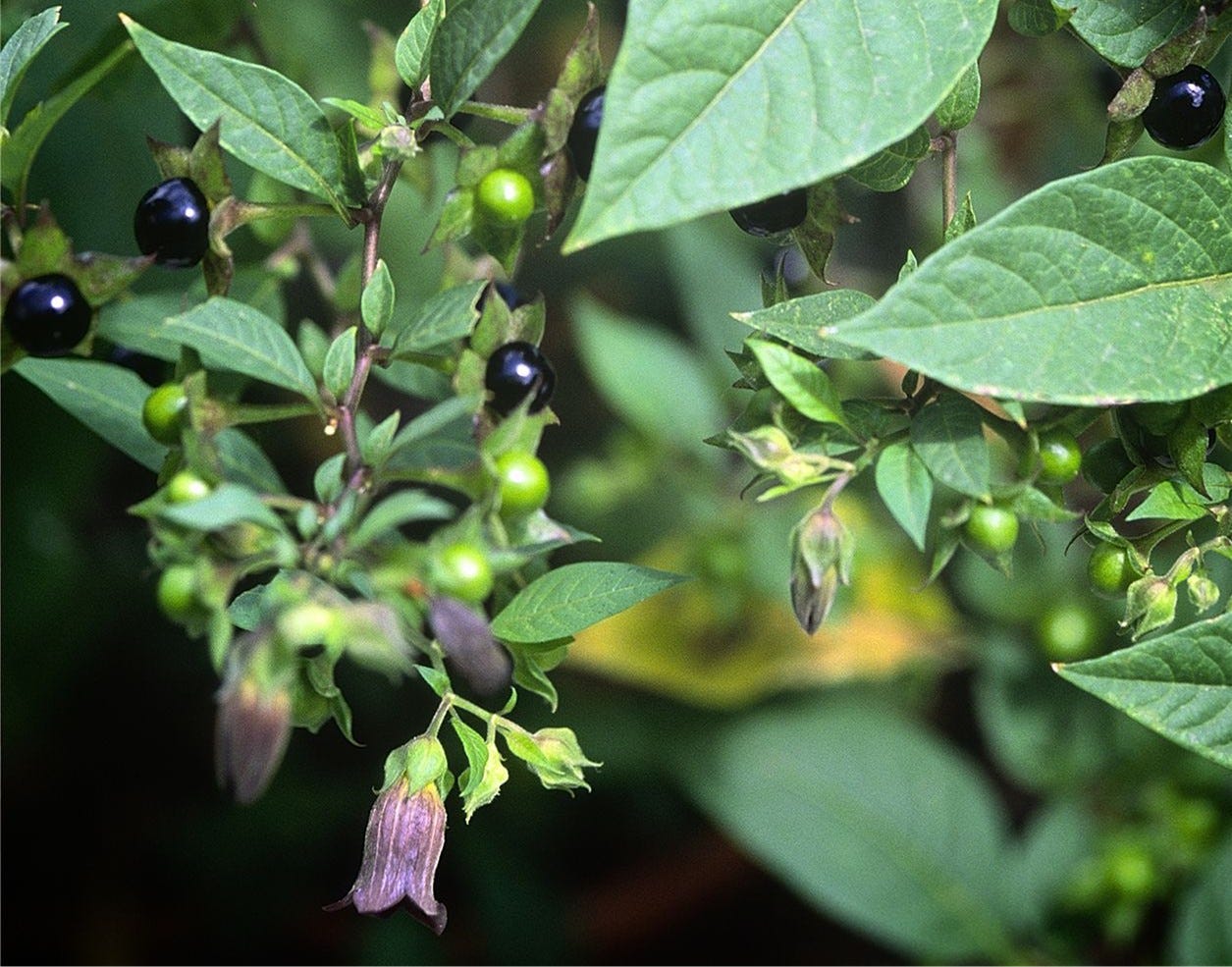BLACK NIGHTSHADE AND GARDEN HUCKLEBERRIES (and some of the in-betweens)
What You Can Really Eat and What You Shouldn't Eat and Why It's All So Confusing
Pretty soon, gardens will have their share of weeds. Some of the berried ones might be edible but probably not. But if they are not, some other gardening friends may think they’re the edible kind because they’ve eaten similar black berries. What to do, what to do?
First, let me say that I hate common names. There’s a wealth of reasons to not put too much trust in them. But that's another article: "BOTANICAL NAMES — SO MUCH EASIER THAN YOU THINK"
Second, taxonomists (those involved in giving botanical names to plants and/or re-naming them) are still working on the genus Solanum (the plants in question here) so we’re still left with some squirrely bits that don't quite clear up the uncertainties gardeners have, particularly the questions about edibility and toxicity. With that in mind, I can only hope this will offer some guidance to those who want to grow the edible species and forms and will do so cautiously.
Solanum nigrum (Black Nightshade), the most common species appearing in gardens (almost always as a weed), is a highly variable species with many varieties and forms described. There are three recognized subspecies. Beyond and above that, this species is now part of what has been taxonomically designated the "Solanum nigrum Complex" (also known as Solanum section Solanum); it’s a group of closely related black nightshade species characterized by their lack of prickles and stellate (arranged star-like) hairs, their white flowers, and their green or black fruits arranged in an umbelliform (umbrella-like) fashion. The Solanum species in this group can be taxonomically confused, especially by intermediate forms and hybridization between the species.
Some of the major species within the S. nigrum Complex are: S. nigrum (of course), S. americanum, S. douglasii, S. opacum, S. ptychanthum, S. retroflexum, S. sarrachoides, S. scabrum (synonyms: S. melanocerasum; S. nigrum var. guineense), and S. villosum. Two of these, S. retroflexum (the “wonderberry” or “sunberry”) and S. scabrum (the “garden huckleberry”) are important in the world of edible gardening. This complex is called the “Morelloid Clade” or “Maurella” (based on Morella; a now defunct taxonomic grouping name proposed in 1813) or simply "the black nightshades."
TOXICITY
The solanine (a soapy glycoalkaloid) levels in S. nigrum have been tested and the plant is rarely fatal (rarely). Solanine poisoning symptoms may occur when immature green fruit (looks similar to green peas) or mature leaves are ingested raw. These symptoms are typically delayed for 6 to 12 hours after ingestion. Initial signs of toxicity include fever, sweating, vomiting, abdominal pain, diarrhea, confusion, and drowsiness. The rare death, which occurs from ingesting large amounts of the plant, results from cardiac arrhythmias and respiratory failure.
Livestock have also been poisoned from nitrate toxicity by grazing the mature leaves and green berries of S. nigrum. Black nightshade is highly variable (hence the “complex”), and it’s wise to avoid eating the berries unless they are a known edible type or strain. The toxin levels may also be affected by the plant's growing conditions. A little aside: other Solanums including tomato, eggplant, and potato contain small amounts of solanine. The solanine builds up in potatoes in storage when exposed to excessive light.
Despite toxicity issues with some forms of Solanum nigrum, the ripe berries and boiled leaves of edible strains (if there really are any) are eaten. The thoroughly boiled leaves — although strong and slightly bitter-flavored — are used like spinach. The ripe black berries of the edible forms have been described as sweet and salty, with hints of licorice and melon — when described most optimistically. Unfortunately, some of the uses ascribed to S. nigrum in literature may actually apply to other black nightshade species within the same species complex, and proper species identification is essential for food and medicinal uses. In other words, when someone says they eat “black nightshade” (or Solanum nigrum), take it with a large grain of salt.
THE EDIBLES
Solanum scabrum is the most intensively cultivated species from this complex. It's primarily grown for its leaf, particularly in Africa. Because of this, it has undergone considerable genetic selection by farmers for leaf size, leaf edibility, overall plant size, and other characteristics, producing several strains/varieties with a focus on leaves. This species seems to be found only in cultivation and not as a garden escape ("weed"), at least not in North America. (Solanum macrocarpon, not a “black” nightshade, produces gigantic edible leaves; it’s an “eggplant” that someone selected for another purpose rather than big “berries.”)
Solanum scabrum also happens to be THE “garden huckleberry.” But, as often happens with common names, that common name has been tagged onto a few other species of Solanum including S. melanocerasum (a name of no botanical standing but now simply a synonym for S. scabrum) and it's even been applied to S. nigrum itself. Making things more mystifying (and dangerous), plenty of seed catalogs simply offer “garden huckleberry” with no botanical name whatsoever. Further complicating matters, there is variability — in looks and taste. This plant has another common name: “Petty Morel Berries” (from the old technical name Morella). In Africa, where the leaf dictated most selection work, there also happens to be a few selected strains that show a reduced height, with more and larger fruit; garden huckleberries were most likely further developed from these.
“Chichiquelite” is one berry-edibility-selected variety/form/strain of Solanum scabrum that was collected in Piedras Verdes, a Mayo community in Sonora, Mexico. Some say this is commonly called Miltomato Valista or “Mexican Huckleberry” (another common name!). Solanum scabrum, by the way, is an Old World species that was introduced into the Americas, so there’s no suggestion here that this is an ancient food of the Mayas. In Mexico, the suffix “-quelite” is a generic term used for potherbs (cooking greens). Chichiquelite may be slightly sweeter, slightly juicier than the species. ‘Hei Tien Tsai’ and ‘Mrs. Bee’s Nonbitter’ are other named forms. Several other popular forms from different black nightshades are available in the commercial trade in Mexico, although the origin of these selections is still not clear and their exact species name is also suspect.
To distinguish Solanum scabrum from S. nigrum: S. scabrum tends to have long petioles with minimal, if any, decurrent leaf blade tissue (= no wrapping or wings around the stem or petiole); otherwise, it is very similar to S. nigrum.
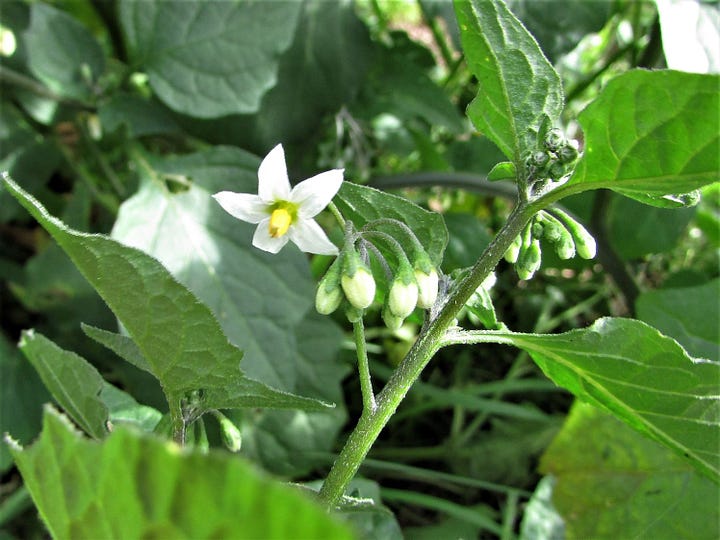
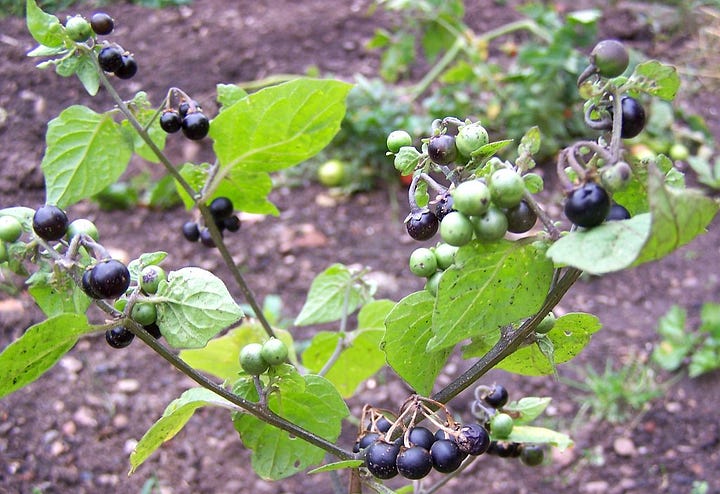
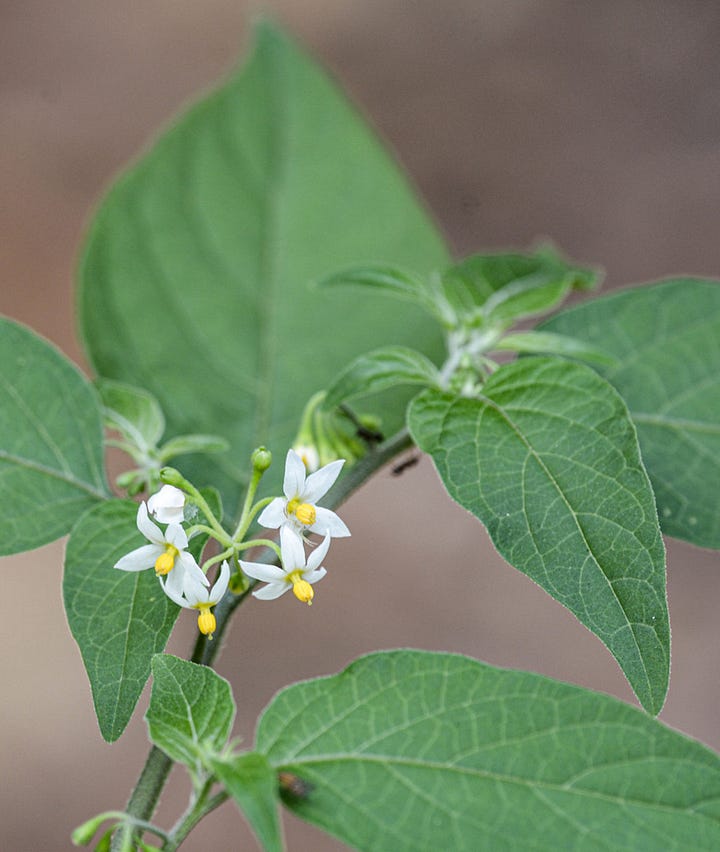

More common name muddling: these “garden huckleberries” are not to be confused with true huckleberries (Vaccinium spp. and Gaylussacia spp.), which are shrubs and belong in an unrelated family. It’s not just the common names that mess things up; in Africa, the botanical name Solanum nigrum is often applied to almost all species of section Solanum with blackish fruits, including Solanum scabrum.
Another edible nightshade that was briefly mentioned earlier, the wonderberry, was originally sold as Solanum × burbankii, in honor of Luther Burbank, the fellow who claimed to have hybridized it in the early 1900s. Some decades later when taxonomists looked just a wee bit closer at this plant, it was discovered to not be a hybrid at all, but rather the species Solanum retroflexum, originally from southern and southeastern Africa. Burbank, a pioneer in marketing new fruits and berries into the U.S., was known for playing a little loose with some marketing.
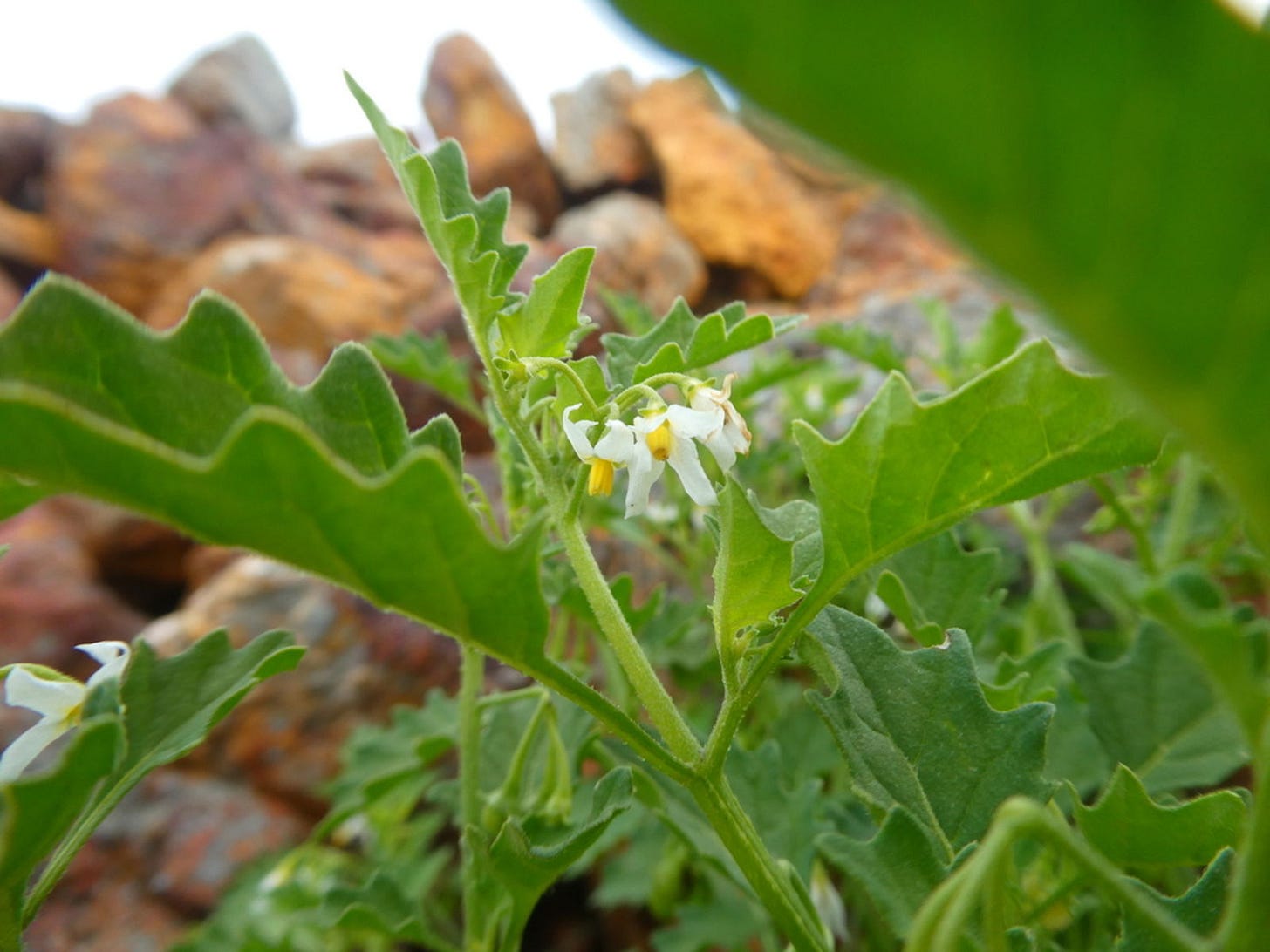
The common names wonderberry and sunberry have also been used for the more common black nightshade (Solanum nigrum) in some places, so care must be taken to distinguish them. Wonderberry is also sometimes called garden huckleberry, but that, again, properly refers to S. scabrum. Wonderberry is genetically close to garden huckleberry as well as to the somewhat edible “golden pearls” (S. villosum). It’s generally a cultivated plant and is uncommon as a garden escape.
TASTE
I'm sure the question about this is in your head. But you know that's a subjective thing. Hence why I won't offer my opinion. But a quick survey of comments in several forums where these plants were discussed — by many people who actually grew them from seed that was sold as an edible form — shows that probably more than 9 out of 10 growers found them to be "not much" at best and "bland," "worthless," and "trash can fodder" at the near-inedible end of the scale. Only 10 percent (probably actually less) found them worth growing again. The other good news: those who grew them from seed from a credible source did not die.
OTHER CONFUSING COMMON NAMES
The species most commonly called simply “nightshade” in North America and Britain is Solanum dulcamara, but to be more distinct, this species should be called “bittersweet nightshade” or “woody nightshade.” Its foliage and egg-shaped red berries are poisonous, with the same active principle being solanine, in this case with enough to cause convulsions and, albeit rarely, death if taken in large doses.
The common name of “Deadly nightshade,” by the way, properly belongs to Atropa belladonna, which is also commonly called belladonna (which has been applied to a couple of other unrelated plants!!). It’s a hardy shrub that’s a member of the nightshade family (Solanaceae), as well.
.
Here’s a purely opiniated and subjective bottom line: there are so many more truly delicious and guaranteed safe to eat (yeah, yeah, “everything is poisonous in the right dose”) black-ish, blue-ish, purplish berry-like fruits, I’m pretty sure none of these Solanum are worth the input. Not yet, anyway.
© Copyright Joe Seals, 2025





